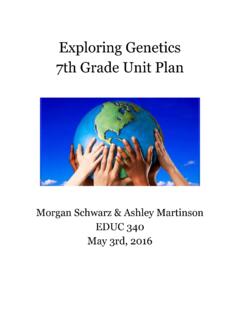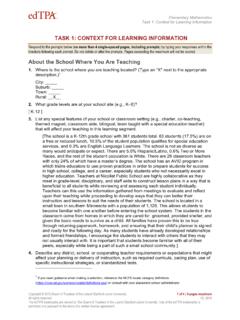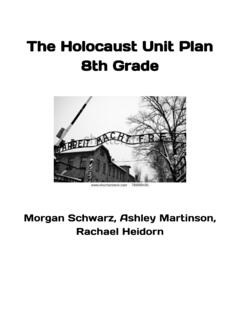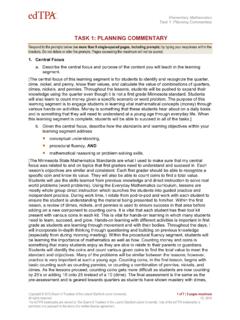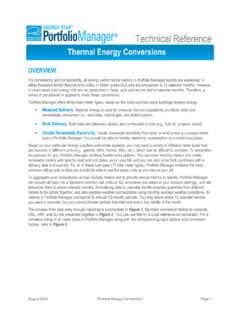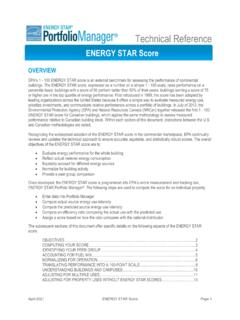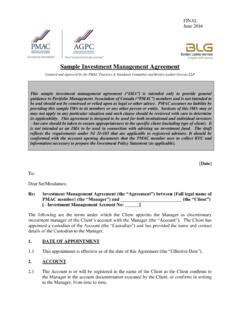Transcription of TASK 1: PLANNING COMMENTARY - Bethany Lutheran …
1 task 1 : PLANNING COMMENTARY Copyright 2016 Board of Trustees of the Leland Stanford Junior University. 1 of 29 | pages maximum All rights reserved. V5_0916 The edTPA trademarks are owned by The Board of Trustees of the Leland Stanford Junior University. Use of the edTPA trademarks is permitted only pursuant to the terms of a written license agreement. task 1 : PLANNING COMMENTARY Respond to the prompts below (no more than 9 single-spaced pages, including prompts) by typing your responses within the brackets. Do not delete or alter the prompts. Pages exceeding the maximum will not be scored.
2 1. Central Focus a. Describe the central focus and the essential literacy strategy for comprehending OR composing text you will teach in the learning segment. [The central focus of the three lessons taught is to define the structural elements of poetry including line, stanza, rhyme, meter, rhythm, and mood. Students will be learning two or more of these elements in a lesson per day. They have the ability to recall these each lesson to build upon them and deepen their understanding as the lessons progress and they look at more poems.] b. Given the central focus, describe how the standards and learning objectives within your learning segment address the essential literacy strategy related skills that support use of the strategy reading/writing connections [The standard addressed throughout the three lessons aligns with the central focus because throughout all of them, the students are identifying the structural elements of poetry.]
3 The prior learned skills the students utilize to help deepen their understanding of the new skills is identifying rhyming words, beat, and syllables. The students do this by playing a game in which they collaborate with their peers to identify rhyming. They also show one another examples of a beat they have heard or created. Through this, they are able to take knowledge they have already attained and apply it to new concepts. The students also will be reading poems throughout the three lessons. After reading the poems, the students and teacher will discuss the meaning of the poem and then apply the concept learned that day to the poem.
4 Through this, the students are exposed to many forms of poetry and the structural elements that create the poems. Also, through reading a variety of poems, the students will have more opportunities to find a poem that meets their interests.] c. Explain how your plans build on each other to help students make connections between the essential literacy strategy to comprehend OR compose text and related skills that support use of the strategy in meaningful contexts. [The three lessons build on one another because each day the students are learning a new strategy that they can apply to almost any poem.
5 In the first lesson, the students learn what a stanza and line is. Throughout the preceding lessons, the teacher will utilize these terms to draw the students attention to specific text within the poems. In the second lesson, the students will learn how to identify a meter. To introduce the concept of meter, students will first review what syllables are. While they are reviewing syllables, they will also learn what stressed and unstressed syllables are. The third lesson utilizes stressed and unstressed syllables to determine a rhythm. Listening to the stressed and unstressed syllables will allow the students to be able to hear a rhythm within the poem.
6 Through this, students are using a concept that they learned in the second lesson to grow their understanding of a new concept in the third lesson. Within the three lessons, students are discovering the structural elements of poetry. Every element students learn, is able to apply it to almost any poem that they encounter in class or on their own. There also poems in the lessons that will encompass some of the previously learned task 1 : PLANNING COMMENTARY Copyright 2016 Board of Trustees of the Leland Stanford Junior University. 2 of 29 | pages maximum All rights reserved.
7 V5_0916 The edTPA trademarks are owned by The Board of Trustees of the Leland Stanford Junior University. Use of the edTPA trademarks is permitted only pursuant to the terms of a written license agreement. concepts, yet will not necessarily be addressed. For example, the students will encounter poems with a rhyme pattern the third day, but will instead be identifying the meter. Through this, the students are still exposed to the structural elements of poetry they have learned, but are learning a new element each day.] 2. Knowledge of Students to Inform Teaching For each of the prompts below (2a b), describe what you know about your students with respect to the central focus of the learning segment.
8 Consider the variety of learners in your class who may require different strategies/support ( , students with IEPs or 504 plans, English language learners, struggling readers, underperforming students or those with gaps in academic knowledge, and/or gifted students). a. Prior academic learning and prerequisite skills related to the central focus Cite evidence of what students know, what they can do, and what they are still learning to do. [Looking at the students pre assessment data, the students were struggling in their ability to identify the structural elements of poetry. Most of the class was unable to define meter, mood, rhyme scheme, and rhythm of a poem.]
9 These are the concepts taught throughout the three lesson. Therefore, the teacher knew that these were concepts the students were in the process of learning. Also because of standards provided by common Core, the teacher knew that the students should have the ability to identify rhyming words and count syllables. These skills will allow the students to identify the rhyme scheme and meter. Because rhyming words and syllables are so important to the concepts, at the beginning of lessons one and two there will be a brief review. The teacher also knew that the students had an understanding of rhythm.
10 This is because the teacher has seen the students model beats and rhythms with their peers during free time periods. Students have also been learning about rhythm and beat in their music class that they have twice a week. Therefore, the teacher has watched many of the students perform a rhythm or beat. However, they had not yet performed a beat while speaking at the same time. This is a skill the teacher will work on during the lesson. The teacher knows the students have an understanding of what mood is. This is because mood is closely related to emotions. From past teaching experience, the teacher knows that from a young age, students talk about and practice emotions.
